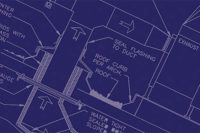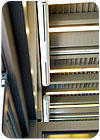
Placing a barrier spot heating system in a vestibule will help keep winter winds at bay. Velocity ranges for these systems should be in the 100- to 150-fpm range.
A big box retail store is a facility with high ceiling space that uses a rack approach for displays. The ceiling height is in the 20- to 25-ft range. The HVAC system traditionally comprises rooftop units (RTU) with little or some ductwork runs to terminal diffusion devices. Some stores have suspended ceilings and other stores have exposed duct distribution. The HVAC system provides heating, cooling, and outdoor air for ventilation.
The HVAC systems of these facilities are often based on a prototype design. This prototype is based on variables of capacity, repeatable layouts, and economic construction/maintenance features. The prototype design selected best meets the criteria listed above. However, climatic conditions, local code requirements, and changes in the retail layouts require variations/changes in the prototype design.
This article will discuss the features of the HVAC systems that present challenges sometimes encountered in these types of stores.
HEATING AND COOLING
Heat loss and heat gain calculations are run to determine the heating and cooling system requirements. The cooling capacity is fairly consistent throughout the U.S., because the facility is basically always in a cooling mode (the cooling mode is determined by the lighting, power, people, and ventilation loads). These buildings are well insulated and heating is mainly required at the doorways and to temper the outside ventilation air. RTUs are selected to provide the necessary heating, cooling, and ventilation (outdoor air) capacity.Heating is provided by either gas or electricity, with gas generally used based on economics. However, in mild and warm regions, elec-tricity is selected because of the low amount needed and the ability to use the wire capacity that was selected for the cooling mode. This choice helps minimize first cost of the system.
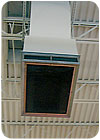
Care should be taken when selecting an RTU to make sure the system is adaptable to the supply and return diffuser/grille connections.
VENTILATION
Exhaust systems are required for ventilation, odor control, restrooms, heat removal, and cooking effluent removal. System capacities are dictated by model codes and/or industry standards. The replacement air is supplied through the rooftop AHUs.The amount of outside air can vary from the minimum exhaust air replacement required to full capacity when the economizer cycles are incorporated into the design. When the economizer cycle is selected, a relief air path is also required.
As a general rule, economizers are not used in warm and humid climates, because there are not enough operational days to warrant the expense of the system. When an economizer cycle is selected, relief roof outlets may be required if the RTU does not have a relief air path.
The exhaust/ventilation/replacement air systems generally operate on a 24/7 schedule. However, in northern climate zones, where heat is required for replacement air, general space ventilation can be reduced if the retail business is not open and the staff is only present for restocking.
Cooking exhaust replacement air quality can also be eliminated when the cooking exhaust systems are "off." The air change replacement requirement must be controlled by a system that inputs data from the operational schedule and the "on/off" controls of localized systems. Building pressure should always be slightly positive relative to the outdoors to control wind and insect inflows through the entrances and loading docks.
The code-required amount of outside air can be negotiated with local code officials based on areas that people use in the facility rather than the gross interior area. Ventilation is also important to control the out-gassing of the chemicals used in the manufacture of clothing sold in these big box stores.
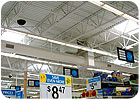
If a large capacity RTU is selected for a facility with no ceiling, the general rule is to use a spiral duct main with grille outlets angled downward.
HEATING CHOICES IN NORTHERN CLIMATES
The basic retail area is heated by the internal heat gains. However, the entrance and loading dock areas are subject to cold winter winds, and barrier spot-heating systems are required for guest and staff comfort. Double-door vestibules are used at the building entrances to provide a climate barrier and are heated from an overhead supply outlet. This system must be designed to blow down at the exterior door, and the velocity range at the occupant level should be 100 to 150 fpm. This velocity will create the barrier but will not be too objectionable or noisy for the guests. In milder climates, the double-door vestibule can be eliminated and only the blow-down design feature maintained at the entrances.An alternate entrance design is to pressurize the interior of the double-door vestibule from the general rooftop HVAC system and use a dedicated warm air barrier system above the interior vestibule door on the interior store side. This design also provides a warmer zone for the cash register zone.
The cash register zone also can be heated from above by using blow-down types of terminal devices such as slot diffusers in suspended-ceiling facilities and directed grilles in open ceiling facilities. The terminal velocity at the cash register line should also be in the 100- to 150-fpm range. This velocity range is relative to using 50 fpm as the definition of "still" air.
Heating in the loading dock area can be accomplished by using either unit heaters or radiant systems. Unit heaters must also be flow-directed downward, and when mounted high, have the fan capacity to deliver the warm air to the occupied level with the 100 to 150 fpm terminal velocity. A radiant system can also be used for spot heating at the loading dock when the building air pressure flows outward to control the winter influence. The dock door arrangement must allow for the downward heat being directed from the radiant source.
COOLING PROBLEMS IN THE SOUTHERN CLIMATES
Avoid the location of cold air terminal outlets too close to the outside doors because the cold supply air mixing with the warm induced air will cause condensation on the terminal outlet surface. This condensation will drip down on the product or people below, which is undesirable. Also, any steel outlets will eventually show rust, which looks bad. As a reminder, there are not enough climatic operational days to warrant an economizer cycle in warm and humid climates, so remember to modify any prototypes that apply to this warning.HEAT RECOVERY
Stores with a grocery department have refrigeration systems for the coolers and freezers. This type of facility can use heat recovery from the air cooled rooftop condensing units. The condenser heat is transferred to the outdoor air-tempering coil. The location of the roof-top AHU and the refrigeration units should be close enough to minimize the heat transfer piping, but not close enough to overheat the RTU outdoor air intake in the summer cooling season.RTU SIZES
RTU size is a function of the required heating and cooling capacity. However, it is also a function of weight for structural considerations, unit cost, delivery availability, access to repair and maintenance services, adaptability to simple supply and return diffuser/grille connections, and power efficiency. The industry has come to standardize on units in the 10- to 15-ton range. Most big box owners also use a national purchasing contract with a given supplier that best meets the needs noted above.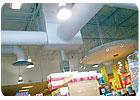
A large diffuser is a good choice when a 10- to 15-ton RTU is used. These diffusers can be either exposed or integrated into the ceiling T-bar system.
TO DUCT OR ONLY TO DIFFUSE?
This is a question that begins with the ceiling or no-ceiling option. The answer depends on the capacity of the RTU relative to the extent of the supply air duct system. If few but larger-capacity RTUs are selected in a facility with no ceiling, the choice of ductwork is often a spiral duct main with grille outlets angled downward.If a 10- to 15-ton RTU is selected, the supply air is directly connected to a large diffuser. These large diffusers can be exposed or integrated into the ceiling T-bar system. The return air path can be part of the diffuser or ducted to the RTU. Another possibility is to use four round duct drops from the RTU and spiral duct runs made for ceiling diffusers in the ceiling T-bar grid.
In projects with suspended ceilings, the concern is with the ceiling tile, adjacent to the diffuser, becoming smudged with induced dirt and dust. One way to control this dirty look has been to provide a clear plastic dam below the ceiling at the edge of the diffuser. This solution, however, causes down blow drafts, which are objectionable to the store's guests.
Another option in a ducted system that utilizes 24- by 24-in. plate diffusers is to use a smaller diffuser in the center of the 24- by 24-in. plate. This option requires more diffuser outlets and comes with greater duct distribution costs.
A newer diffuser option is to drop the diffuser face below the surface of the ceiling plane, thus avoiding the induction surface adjacent to the diffuser. This type of diffuser requires a custom design with a given vendor and a national purchasing contract.
RETURN AIR DUCTING IN THE SERVICE OFFICE AREA
The service office area is often made up of the security control area, the cash office, the training room, the management office, the staff lunchroom, and any other rooms with closed doors. The supply air in this area comes from an RTU and requires a return air path. The ceiling plenum return option is not used because of the danger of non-fire rated materials being used in the plenum. Transfer ducts are used to create the return air path to the return area of the RTU. A discussion must be held with local code officials to determine the need for fire or fire/smoke dampers in the transfer duct path.A COMMERCIAL KITCHEN EXHAUST SYSTEM
The facility may have a popcorn machine, a microwave oven in the staff lunchroom, a coffee bar, a pizza snack bar, and/or a fast food server. Each of the exhaust systems for these spaces may or may not require a code-required commercial kitchen Type I or Type II exhaust system. Review the food service exhaust areas with the local code officials to get it right in the design stage. If there may be a kitchen hood some day in the future, then the time to install the Type I grease fan/duct system is now rather than later. The system can be installed as a Type II exhaust duct for heat and smoke from a pizza oven or popcorn machine, and then later converted to a Type I by adding the insulated duct wrap in the ceiling plenum.‘GREEN' MEP OPPORTUNITIES
These types of facilities offer daylighting possibilities, heat recovery from the refrigeration systems, water savings using waterless urinals, sensor water faucets and sensor flush valves, and site water retention for irrigation.The amount of outside air can be varied using CO2sensing. Another outside air strategy is to reduce the outside air during stocking periods at night when the occupancy level is reduced.
SUMMARY
The big box design process always starts with a prototype, which is always subject to change as the goals of the retail market change. If you note a request for a retail-driven change, collaborate with the entire design team to confirm which stores will incorporate the change.The prototype is also subject to the local weather conditions in the U.S. The general zones of variation are the cold northern zone, the temperate middle zone, the warm and humid southern zone, the dry desert cooling zone, and the high-altitude zone. Each of the heating/cooling zones needs a change in the way that the outdoor air is handled, for example, the high-altitude zone also needs a change in fan hp to deliver the required system fan capacity.
Local codes and local code officials are always a variable in the design process. Check with the local code official about the possible variations discussed in this article.
Stay in contact with the construction supervisors to obtain feedback on any prototype problems. Provide the solutions to these field problems on the next store cycle. Time and money considerations are important in retail construction. Any code or field changes may result in project "extras" and construction delays, which are unacceptable in this design arena.
The big box design market is unique because of the high ceiling space. This results in greater distances for the heat and cooling to travel to the guest occupied zone, a challenge joined by the pressures of time/money, the need to satisfy the retail driven "look," and the whims of the local code officials.

